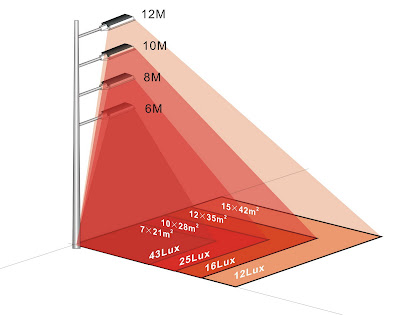The LED street lighting (often called LED road lighting) is an integrated light-emitting diode (LED) light fixture that is used for street lighting. Because they are more energy efficient than other technologies used for street lighting, LED street lights can cut by more than half the cost of keeping streets well lighten when dark.
A LED streetlight is an integrated light that makes use of LEDs as its light source. These are thought about integrated lights because, in most cases, the luminaire & the fixture are not separate parts. New in manufacturing, the LED light cluster is sealed on a panel & then assembled to the LED panel with a heat sink to become an integrated lighting fixture.
Different designs have been made that incorporate various types of LEDs in to the light fixture. The current trend is to make use of high power one watt LEDs, but some companies use low power LEDs in their products, including several low power LEDs packed together to perform the same purpose as a single high power LED. The design of the LED streetlight depends on several factors, including LED configuration, the heat sink used with the LEDs, & aesthetic design preference.
The lifespan of a LED streetlight is made by its light output compared to its original design specification. When the LED steert light brightness decreases by 70 percent, an LED streetlight is thought to be at the finish of its life.
Heat sinks for LED street lights are almost the same in design to heat sinks used to chill other electronics such as laptops, computers. Heat sinks tend to have a lot of grooves they can support to facilitate the flow of hot air away from the LEDs. The area of heat exchange will directly affect the lifespan of the LED streetlight.
Most LED street lights have a lens on the LED panel, which is made to cast its light in an rectangular pattern, an advantage compared to traditional street lights, which usually have a reflector on the back side of a high-pressure sodium lamp (HID). In this case much of the luminance of the light is lost & produces light pollution in the air & surrounding areas. Such street lights can also cause glare for pedestrians & drivers.
A drawback of LED focus panels is that most light is directed to the road, & less light to the footpaths & other areas. This can be addressed by the use of specialized lens design & adjustable mounting spigots.
Energy efficiency of LED street lighting
The primary target of LED street lighting is energy efficiency compared to incandescent bulbs of the same luminance. Research continues to improve the efficiency of the new models of street lighting. Such of advance can be present in a streetlight product created by Lighting Science Group. A model of LED street lights produced by this group is up to 60 percent more efficient than earlier models, lasts for 12 years, and it can recover your costs through energy savings in only 2-3 years.
A LED streetlight based on a 901 milliwatt output LED can normally make the same amount of (or higher) luminance as a traditional light, but requires only half of the power consumption.



No comments:
Post a Comment